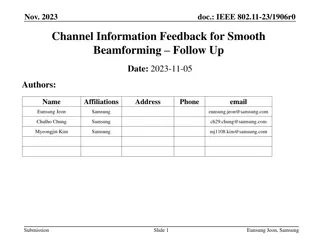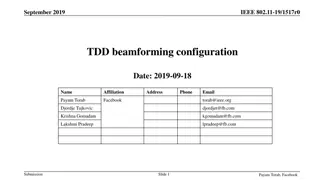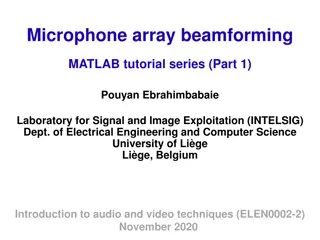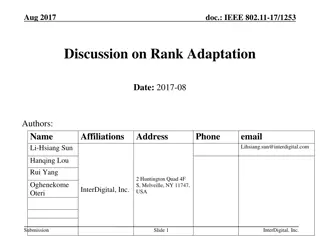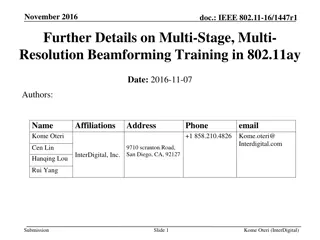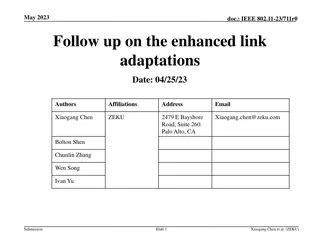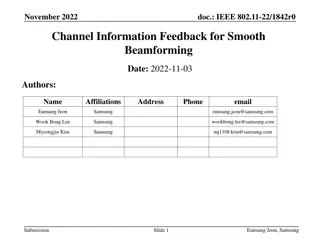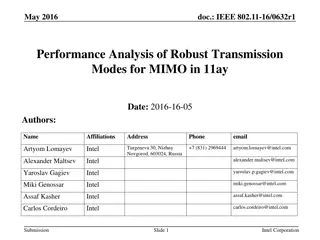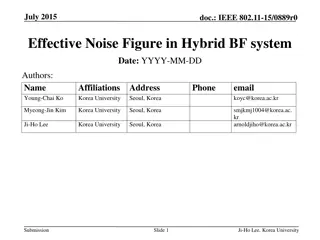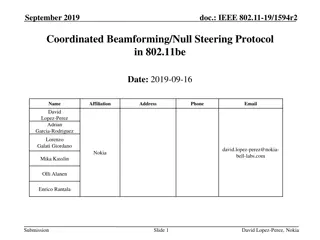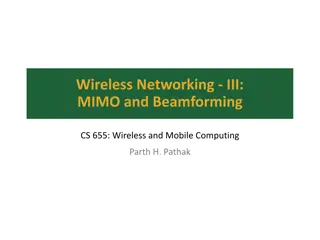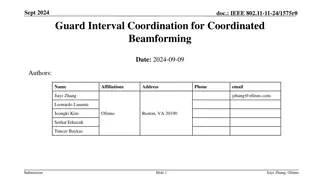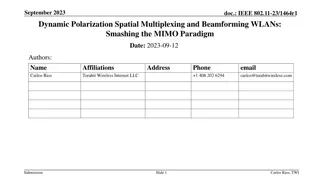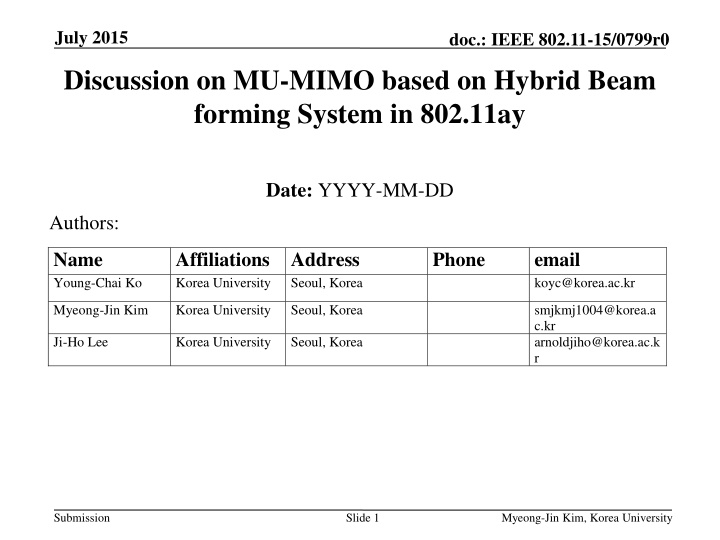
Discussion on MU-MIMO Hybrid Beamforming System in 802.11ay
Explore the need for MU-MIMO in 802.11ay and parameters for supporting it, with a focus on hybrid beamforming and codebooks. Delve into the design challenges and considerations for efficient beamforming in MU-MIMO systems.
Download Presentation

Please find below an Image/Link to download the presentation.
The content on the website is provided AS IS for your information and personal use only. It may not be sold, licensed, or shared on other websites without obtaining consent from the author. If you encounter any issues during the download, it is possible that the publisher has removed the file from their server.
You are allowed to download the files provided on this website for personal or commercial use, subject to the condition that they are used lawfully. All files are the property of their respective owners.
The content on the website is provided AS IS for your information and personal use only. It may not be sold, licensed, or shared on other websites without obtaining consent from the author.
E N D
Presentation Transcript
July 2015 doc.: IEEE 802.11-15/0799r0 Discussion on MU-MIMO based on Hybrid Beam forming System in 802.11ay Date: YYYY-MM-DD Authors: Name Young-Chai Ko Affiliations Address Korea University Phone email koyc@korea.ac.kr Seoul, Korea Myeong-Jin Kim Korea University Seoul, Korea smjkmj1004@korea.a c.kr arnoldjiho@korea.ac.k r Ji-Ho Lee Korea University Seoul, Korea Submission Slide 1 Myeong-Jin Kim, Korea University
July 2015 doc.: IEEE 802.11-15/0799r0 Abstract In [1], MU-MIMO scheme for 802.11ay was introduced. In this presentation, we further discuss on the need for MU- MIMO and the parameters which should be determined to support MU-MIMO in 802.11ay. Also, we consider codebooks for hybrid beamforming to support MU-MIMO. Submission Slide 2 Myeong-Jin Kim, Korea University
July 2015 doc.: IEEE 802.11-15/0799r0 Need for MU-MIMO in 802.11ay 802.11ay considers many usage scenarios as follows [2]. Ultra short range (USR) communications Augmented reality and virtual reality Video/mass-data distribution/video on demand system Etc. In order to use 802.11ay for a scenario such as video/mass-data distribution/video on demand system, 802.11ay may support multiuser transmission. Submission Slide 3 Myeong-Jin Kim, Korea University
July 2015 doc.: IEEE 802.11-15/0799r0 Hybrid Beamforming for MU-MIMO System model STA 1 AP MIMO decoder ADC BB filter H DAC 1 DAC MIMO decoder Channel Digital/baseband beamforming Analog/RF beamforming BB filter H K STA K DAC ADC Digital/baseband beamforming Analog/RF beamforming Analog/RF beamforming Submission Slide 4 Myeong-Jin Kim, Korea University
July 2015 doc.: IEEE 802.11-15/0799r0 Parameters for MU-MIMO in 802.11ay We consider the hybrid beamforming to support DL MU-MIMO transmission in 802.11ay. Therefore, the following parameters should be considered. The number of RF chains in AP (NRF) is equal to or lager than the maximum number of data streams (that is, spatial multiplexing gain), which AP can transmit. The number of RF chains in STA k ( ) is equal to the maximum number of streams that STA k can decode. Parameter inequality U k NRFwhen U is the number of service users. k=1 NUSER, RF Submission Slide 5 Myeong-Jin Kim, Korea University
July 2015 doc.: IEEE 802.11-15/0799r0 Beamforming Design Problem for MU-MIMO Hybrid Beamforming Problem formulation As the number of STAs and the size of codebook increase, the overhead required to determine the RF/digital beams exponentially increases. Low complexity and low overhead hybrid beamformming algorithm is required! Submission Slide 6 Myeong-Jin Kim, Korea University
July 2015 doc.: IEEE 802.11-15/0799r0 Codebooks for Hybrid Beamforming Different codebooks may be considered for RF/digital beamforming due to their respective properties. Candidate codebooks for RF beam Codebook in IEEE 802.15.3c (WPAN) DFT-based codebook Beamsteering codebook Candidate codebook for digital beam Grassmannian codebook Submission Slide 7 Myeong-Jin Kim, Korea University
July 2015 doc.: IEEE 802.11-15/0799r0 Procedure of Designing MU-MIMO Hybrid Beamforming (1/2) STA 1 AP MIMO decoder ADC BB filter H DAC 1 DAC MIMO decoder Channel Digital/baseband beamforming Analog/RF beamforming BB filter H K STA K DAC ADC Digital/baseband beamforming Analog/RF beamforming Analog/RF beamforming 1 2 3 Determination of RF beamforming/filter Design of digital beamforming/filter Feedback of effective channel information Submission Slide 8 Myeong-Jin Kim, Korea University
July 2015 doc.: IEEE 802.11-15/0799r0 Procedure of Designing MU-MIMO Hybrid Beamforming (1/2) Stage 1: Determination of RF beamforming/filter Without considering the effect of digital beamforming/filter, RF beamforming/filters for each user are selected based on the beam training. Stage 2: Feedback of effective channel information AP sends the pilot sequence. Each STA estimates and quantizes its effective channel (the product of full channel matrix and RF beamforming/filters). Each STA feeds back the index of the quantized channel to AP. Stage 3: Obtaining digital beamforming/filter AP calculates the digital beamforming/filter based on the quantized channels and forwards the digital filters to STAs. Submission Slide 9 Myeong-Jin Kim, Korea University
July 2015 doc.: IEEE 802.11-15/0799r0 Conclusion We discussed on the need for MU-MIMO and the parameters which should be determined to support multiuser in 802.11ay. We suggested the procedure to design the hybrid beamforming for DL MU transmission. Submission Slide 10 Myeong-Jin Kim, Korea University
July 2015 doc.: IEEE 802.11-15/0799r0 References [1] IEEE 802.11-15/0356r0, MU-MIMO schemes for NG60 [2] IEEE 802.11-15/0328r4, NG 60 Use Cases Submission Slide 11 Myeong-Jin Kim, Korea University


